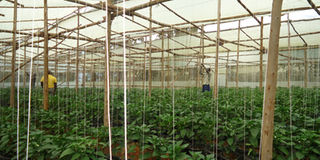Using nets to combat the pest menace and getting higher yields

Farm workers tend to vegetables in a greenhouse. Use of nets over crops is a cheaper alternative to greenhouses. PHOTO BY FRED MUZAALE.
What you need to know:
While not many farmers can afford greenhouses, there is an alternative that works just as well.
Just like how one would prevent malaria by sleeping under a bed net, the same protection mechanism can apply to plants, which like human beings, are not only exposed to diseases transmitted by insects. This is also damage caused which farmers are all too aware can lead to total losses.
The market for horticulture crops is affected as a result of pest infestation because once damaged, customers tend not to buy them. Crops such as French beans suffer infestation from whitefly and several vegetables are usually destroyed by aphids, red spider mites and nematodes.
This led scientists at Kenya Agricultural and Livestock Research Organisation (KALRO) to carry out a study using nets to cover crops in fields to counter pest infestation.
Known as AgroNet, it is one of a number of clear netting products developed for use with vegetables, fruit and ornamentals to control pests and reduce quantities of pesticides that would have been applied. The nets provide farmers with affordable alternatives to more expensive greenhouses as they can as well use them to cover crops not grown in green houses.
Partnership
The BionetAgro initiative was launched by Cirad, a French research organisation, and A to Z Textile Mills, a Tanzanian company and supported by a Usaid-funded research project involving stakeholders in Kenya, Tanzania, Benin, France and USA.
Dr Lusike Wasike, who heads the project at KALRO, says vegetable farmers tend to use pesticides, and sometimes misuse, leading to negative effects on humans, animal and other organisms. Her team is therefore promoting the use of nets among these farmers. The nets contain spores and what a farmer can do is throw them over the crops.
Farmers in Kenya growing tomatoes and pyrethrum, and those multiplying seedlings in nurseries are now using these nets.
Barrier to animals
The crops tend to have clean environment which enables them grow faster. But since the nets are non-biodegradable, farmers are advised to use them for a period of four to six years.
In Benin, farmers use them for six years in a crop cycle but the ones in Kenya use them for four years and discard them for recycling. The researchers are testing them mainly in high rainfall areas, which tend to harbour pests that infesting crops.
In the net, pesticides can be embedded to check the insects, which enter through the spores. In addition to this, nets act as a barrier to animals may graze in farmers’ fields.
Effective measures
Dr Sophie Musana, in charge of the horticulture programme at National Crop Resources Research Institute (NaCRRI), points out that nets are not used as much by farmers in Uganda. Though, she says, they are effective for those growing tomatoes, red pepper and green vegetables. At Namulonge, the scientists are using them at trial sites.
However, farmers are also advised to use integrated pest management of applying manure made out of animal waste mixed with pepper, animal urine and ash to repel pests. There are certain plants, which act as a repellent to pests.
For purposes of pollination to occur from flying insects such as bees, farmers are advised to cover these crops from 6pm to 6pm in the night and uncover them during day.
Use of nets as an intervention measure for pests
In 2011, A to Z Textile Mills promoted the use of AgroNet on cabbage, which resulted in less pesticides and better income for farmers in countries where the project is being implemented.
Today, after on-station and on-farm testing, scientists at KALRO indicate that they would also highly recommend this technology as part of the pest and disease management regime in French beans.
Nets are not only recommended for cabbage and French beans. According to data generated and published by Egerton University scientists, they have a good effect on tomatoes and vegetable seedlings in the nursery.
The research in observing the trends with cabbage netting showed yields are 52-59 per cent higher than unprotected cabbages.
The other findings were 44-50 per cent higher than chemically treated but not covered cabbages.
Besides research done in Nairobi and at Egerton University, in Nakuru 14 demonstration plots were set up by a company called TransGlobal. Other plots were set up in Limuru, Nyeri, Nakuru, Eldoret and Kitale.
These demonstration plots have resulted in a number of farmers adopting the technology in a bid of realising increased yields from their farms.




